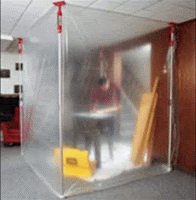Common Misconceptions
about Professional Carpet Cleaning
Misconception #1: You should wait as long as possible
before cleaning your carpet. Or
Having your carpet cleaned too frequently will damage the
fibers
No. Dirt is an abrasive like sandpaper. Every time you step
on the carpet, you grind dirt into your carpet fibers. This cuts your carpet,
just as if you had used a knife, causing it to wear out faster. A dirty carpet
will not last nearly as long as a clean carpet. And while vacuuming helps, it's
simply not enough. Proper vacuuming only recovers 85% of the soil that your
carpet accumulates. The longer you wait to have your carpet cleaned, the more
damage you do and the faster it wears out.
Misconception #2: The only reason to clean carpets is
to get out the dirt.
No. Indoor air quality is greatly affected by the condition
of your carpet. As you probably know, outdoor air contains pollens, fungus,
bacteria, air pollution, cigarette smoke, car exhaust, and hundreds of other
chemicals. When you and your family members come into your home, you carry
those pollens, bacteria and chemicals in your hair, on your skin, clothing and
shoes. As your homes largest filter, all those chemicals, pollens and bacteria
wind up in your carpet.
Misconceptions #3: One method of carpet cleaning is
as good as another.
No. Dry Cleaning vs. Hot Water Extraction.
DRY CLEANING: / CARPET ABSORBENT CLEANERS
A dry absorbent compound (containing small amounts of water,
detergent, and solvent,) is sprinkled over carpet or worked into the carpet
with a machine. This purpose of this cleaner is to attract and absorb soil.
Mechanical agitation from a brush works the cleaner through the carpet.
These products usually contain an absorbent carrier, water,
detergent, and solvent. The theory is that the liquids dissolve the soil and
this soil/detergent/solvent mixture is absorbed into the carrier and is then
vacuumed up. They are often used with a detergent pre-spray in heavily soiled
areas.
The absorbent cleaner most commonly is organic, but may also
be polymers. The compound is supposed to absorb the dislodged soil and is then
vacuumed away. Carpet must be thoroughly vacuumed before and after cleaning.
Very thorough vacuuming should be used to ensure that most
of the carrier comes out of the carpet. With the extremely fine powder types,
indoor air quality can be reduced. If a white powder starts appearing on shoes
and cuffs of pants, too much was used and it was not thoroughly vacuumed up
Manufactures who recommend this type of cleaning also state
that for deep cleaning, Hot Water Extraction is the preferred method.
The reasons why some companies use low moisture cleaning
methods are: 1) They dry fast, 2) They are easy to produce, 3) Technicians can
work very fast, 4) The price is cheaper than a properly done hot water extraction
process.
HOT WATER EXTRACTION CARPET CLEANING
This is the cleaning method nearly all carpet manufacturers
and carpet fiber producers recommend.
This is the only cleaning method classified as "deep
cleaning". All the others are considered "light surface
cleaning" because they are incapable of removing soil deep in the pile.
Also, all other methods leave large amounts of cleaning agent in the carpet
after cleaning.
The maintenance brochure published by the world's largest
carpet manufacturer, Shaw Industries, recommends this method, because its own
research indicates that it provides the best capability for cleaning.
This method is frequently called "steam" cleaning
due to the fine spray of water used to force dirt out of the carpet which is
sucked up by the vacuum slot immediately in front of the spray. Seldom is real
live steam used, however. This process consists of spraying a solution of water
and detergent into the carpet pile and recovering the water and soil with a
powerful vacuum into a holding tank. This can be done from a truck-mounted unit
outside the home with only the hose and floor tool brought inside, or by a
portable, system brought into the home or office.
From a health standpoint, the truck-mounted system is
preferred because the dirty air and humidity are exhausted outside rather than
re-circulated around the house. Additionally, truck-mounted systems usually are
more powerful than portable units and do a much better cleaning job and get the
carpet dry more quickly.
Misconception #4: Having the right equipment is all a
company needs to clean your carpets properly.
Not true. Many companies own hot-water cleaners, but a large
number of employees don't know how to use them. The best carpet cleaning
companies are those that have the Institute of Inspection,
Cleaning and Restoration Certification, known as the IICRC. A carpet cleaning
company cannot buy this certification. The carpet cleaner must earn the
certification through study, experience, and the successful completion of formal,
written examinations. Cleaners who are certified by the IICRC have, in effect,
earned a degree in carpet cleaning.
The IICRC provides written credentials to the companies it
certifies. So before you choose a carpet cleaner, ask to see written proof of
the company's IICRC certification.
Misconception #5: Any honest carpet cleaning company
should be able to give you an exact price quote over the telephone.
We wish this were true, but it isn't. Consumers often think
that if they want to clean four rooms there should be a price set for the
cleaning.
Honest, reputable carpet cleaning companies price carpet
cleaning by the square foot. We are only going to charge for the space that we
actually clean. So if you'd like us to tell you the exact cost of cleaning your
carpet, we need to know the exact number of square feet that you want cleaned.
To get an accurate measurement, a technician will need to be scheduled to come
and measure the areas you want to have cleaned. Quotes from Arizona Hydro-Pro
are free of charge!







